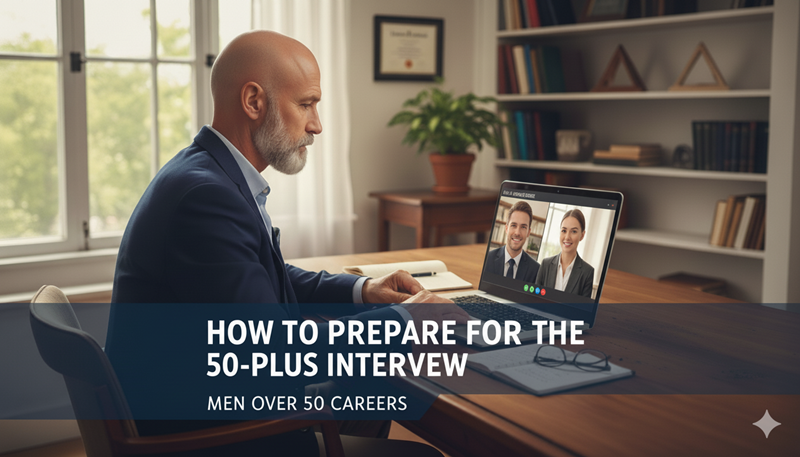Practical CV Tips for Men Over 50
🤔 Let’s be honest, creating resumes isn’t our most favorite pastime and the traditional CV playbook most of us learned decades ago just doesn’t work anymore. Employers needs have changed, they still need new employees but they have much less time to devote to the job search. So employers and employment agencies expect software to automate the search and only show them most relevant candidates for any job opening.
👇 Today, recruiters use AI-driven screening tools, hiring managers expect concise storytelling, and personal branding matters almost as much as technical skills.
But here’s the good news ✅ experience still counts. You just need to package it in a modern, relevant way.
Below are practical, real-world tips to make your resume work for you, not against you, especially if you’re over 50 and ready to re-enter or re-energize your career.
💡 1. Think of Your Resume as a Marketing Document — Not a History Lesson
The biggest mistake experienced professionals make is turning their resume into a timeline instead of a highlight reel. Think of your resume as the trailer for a new movie, but you’ve only got 6 to 8 seconds to grab the reader and leave them wanting to know more.
Recruiters aren’t really interested in what you did in 1997, they want to know how you can help them now.
🔹 Trim the early years: Summarize pre-2005 roles under a short “Early Career Highlights” section.
🔹 Focus on achievements: Replace task lists with quantifiable impact, “Cut costs by 30% through process redesign” is much stronger than “Managed budgets.”
🔹 Mentoring new hires: Any time you spent bringing new members of the team up to speed is time well spent and shows you are not only knowlegeable but approachable and able to convey information intelligently.
🔹 Tailor to today: Align your profile with the skills employers actually search for, adaptability, collaboration, tech literacy, and reliability.
Remember, the goal is to show you’re current, capable, and ready to contribute immediately.
✍️ 2. Use a Modern Resume Format
Make sure that your CV doesn’t look like it came from the fax era 😅. It’s vital that the visual design stands out and it matters more than you might think, not because it’s flashy, but because it signals you’re up to date.
✅ Use a clean, single-column layout with clear headings and plenty of white space.
✅ Drop the address — just city and LinkedIn URL are enough.
✅ Use a professional summary instead of an “objective.” It’s your 3-line elevator pitch.
Here’s a sample structure that works well:
Header: Name | Location | Email | LinkedIn | Phone
Summary: 3-4 sentences describing your strengths and focus area.
Core Skills: 6–10 keywords relevant to the role.
Experience: 10–15 years of recent roles with achievements.
Education & Certifications: Keep it concise.
Tech Skills or Tools: Yes, include these — it shows digital confidence.
A modern design template from tools like Canva, Google Docs, or LinkedIn Resume Builder can instantly lift your presentation without needing a designer.
Words unintentionally signal that your resume hasn’t been updated in a while.
❌ Outdated: “Responsible for…”, “References available on request”, “Managed staff of 10”
✅ Modern: “Led a team of 10 to deliver…”, “Achieved measurable results…”, “Collaborated across departments…”
Use action-oriented language, words like led, delivered, built, improved, launched, streamlined.
And where possible, quantify your results. Numbers cut through the noise:
➡ “Increased sales by 25% in 12 months” sounds like someone who gets results.
🌐 4. Show You’re Tech-Savvy (Even If You’re Not a “Tech Guy”)
While you don’t need to show you can write code, you do need to show digital competence and fluency.
💻 Mention tools you’ve actually used, Microsoft Teams, Excel, CRM systems, Zoom, or even WhatsApp Business.
📱 Add a line that shows you learn continuously,“Completed LinkedIn Learning course on Excel for Professionals.”
Employers need candidates who can easily adapt to new tech changes, not resist them. Showing curiosity and comfort with digital tools instantly signals relevance.
🤝 5. Highlight Soft Skills That Only Experience Teaches
There’s one thing younger candidates can’t compete with, and us older guys tend to forget, our decades of real-world experience and wisdom.
Lean into it.
💡 Include skills like:
- Leadership under pressure
- Mentoring junior colleagues
- Stakeholder management
- Problem-solving through experience
- Calm decision-making in uncertain situations
Don’t hide your maturity, position it as your advantage.
🧠 6. Add a “Modern Mindset” Section
This section is optional, but very powerful. A short section titled “Continuous Learning” or “Recent Development” can show you’re not stuck in the past.
Example:
Continuous Learning:
- Completed Google Workspace Productivity course (2024)
- Regular contributor to LinkedIn industry discussions
- Attended local business networking meetups
This tells employers: “I’m active, engaged, and always learning.”
🔍 7. Optimize for AI and Applicant Tracking Systems (ATS)
Many resumes are filtered by software before a human sees them.
That means keywords are key 🔑.
💼 Read the job description carefully and mirror the language it uses.
💼 Use standard job titles — “Project Manager,” not “Solutions Guru.”
💼 Save as a Word (.docx) or PDF format that preserves text (no images for text fields).
AI tools can be a huge advantage here, try ChatGPT, Rezi, or Teal to analyze your CV for keyword strength and readability.
💬 8. Don’t Forget Your LinkedIn Profile
Remember that your LinkedIn profile is now part of your resume. Many employers look there first, sometimes instead of your CV.
✅ Add a professional headshot (no holiday backgrounds). CV’s should not contain photos.
✅ Write a compelling headline — not just your job title.
✅ Keep your “About” section conversational, confident, and focused on value.
✅ Post occasionally — share an article, comment thoughtfully, or celebrate a milestone.
✅ Ensure your CV and LinkedIn profile don’t contradict each other.
Your online presence is often the first impression before your CV even arrives.
🚀 Final Thought: Your Experience Is Your Edge
If you’ve worked for 25 or 30 years, you’ve built something most companies desperately need today, reliability, judgment, and adaptability.
The secret isn’t to hide your age. It’s to present your experience in a modern frame.
Stay current, show curiosity, and keep your story focused on what you can contribute now.
That’s how a resume, and a career, stays relevant after 50. 💪



